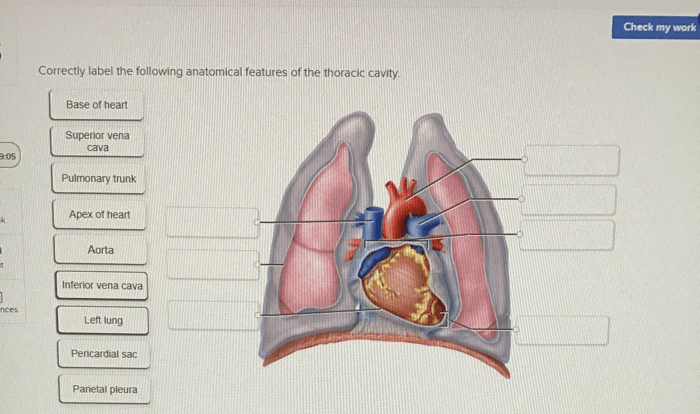Chapter 22 the nervous system – Chapter 22: The Nervous System embarks on an enthralling exploration of the intricate network that governs our thoughts, actions, and sensations. Delve into the depths of the human body’s command center, where the nervous system orchestrates a symphony of electrical and chemical signals, shaping our perceptions and connecting us to the world around us.
From the bustling metropolis of the brain to the intricate pathways of the spinal cord, we unravel the mysteries of this extraordinary system, deciphering its structure, functions, and the fascinating interplay between neurons, synapses, and neurotransmitters. Prepare to be captivated as we journey into the realm of the nervous system, a testament to the marvels of human biology.
Overview of the Nervous System
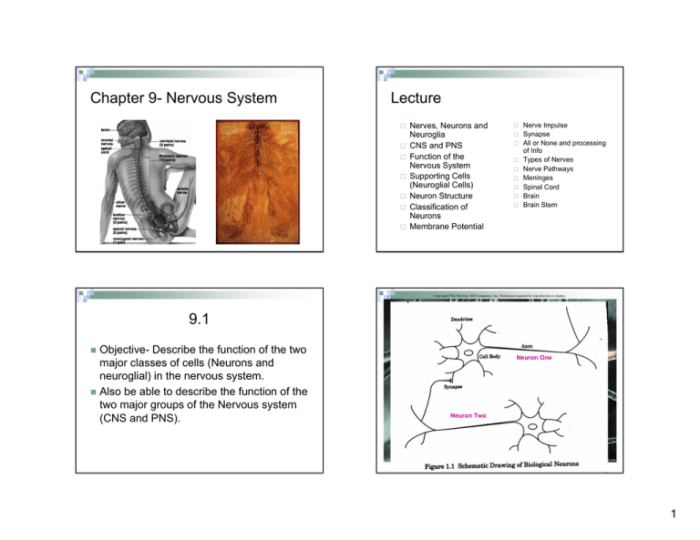
The nervous system is a complex network of cells, tissues, and organs that work together to control all bodily functions, including movement, thought, and emotion. It receives sensory information from the environment and internal organs, processes it, and sends out motor commands to muscles and glands.
The nervous system is divided into two main divisions: the central nervous system (CNS) and the peripheral nervous system (PNS).
Central Nervous System
The CNS consists of the brain and spinal cord. The brain is the control center of the body, responsible for processing information, making decisions, and controlling movement. The spinal cord is a long, thin bundle of nerves that runs from the brain down the back.
It carries messages between the brain and the rest of the body.
Peripheral Nervous System
The PNS consists of all the nerves that connect the CNS to the rest of the body. It is divided into two parts: the somatic nervous system and the autonomic nervous system.
The somatic nervous system controls voluntary movements, such as walking, talking, and writing. The autonomic nervous system controls involuntary functions, such as breathing, digestion, and heart rate.
Central Nervous System (CNS)
The Central Nervous System (CNS) is the control center of the body, responsible for processing information, making decisions, and coordinating actions. It consists of two main components: the brain and the spinal cord.The brain is the most complex organ in the body, composed of billions of neurons that communicate through electrical and chemical signals.
It is divided into three main regions: the cerebrum, the cerebellum, and the brainstem.The cerebrum is the largest part of the brain and is responsible for higher-level functions such as thinking, reasoning, and memory. It is divided into two hemispheres, each of which is further divided into four lobes: the frontal lobe, parietal lobe, temporal lobe, and occipital lobe.
Each lobe has specific functions, such as controlling movement, processing sensory information, and managing language.The cerebellum is located at the back of the brain and is responsible for coordinating movement and balance. It receives sensory information from the muscles, joints, and vestibular system (which detects head movement) and uses this information to adjust muscle activity and maintain equilibrium.The
brainstem is the lowest part of the brain and connects the cerebrum and cerebellum to the spinal cord. It controls vital functions such as breathing, heart rate, and blood pressure.The spinal cord is a long, thin bundle of nerve tissue that runs from the brainstem down the back.
It carries sensory information from the body to the brain and motor commands from the brain to the muscles. The spinal cord is also responsible for simple reflexes, such as the knee-jerk reflex.
Peripheral Nervous System (PNS)
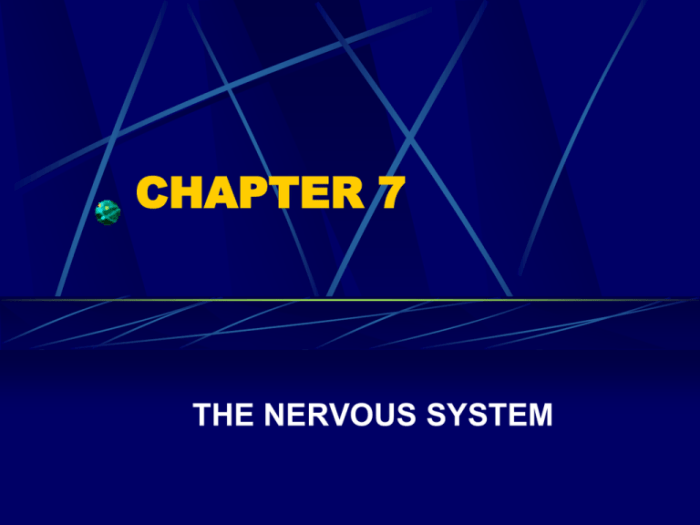
The peripheral nervous system (PNS) connects the central nervous system to the rest of the body, including the muscles, organs, and glands. It consists of two main divisions: the somatic nervous system and the autonomic nervous system.
Somatic Nervous System, Chapter 22 the nervous system
The somatic nervous system controls voluntary movements, such as walking, talking, and writing. It consists of sensory neurons that transmit information from the body to the central nervous system, and motor neurons that carry signals from the central nervous system to the muscles.
Autonomic Nervous System
The autonomic nervous system regulates involuntary functions, such as heart rate, blood pressure, and digestion. It is divided into two branches: the sympathetic nervous system and the parasympathetic nervous system.
Sympathetic Nervous System
The sympathetic nervous system prepares the body for “fight or flight” responses during times of stress or danger. It increases heart rate, blood pressure, and breathing, and dilates the pupils.
Parasympathetic Nervous System
The parasympathetic nervous system promotes “rest and digest” activities. It decreases heart rate, blood pressure, and breathing, and constricts the pupils.
Neurons: Building Blocks of the Nervous System
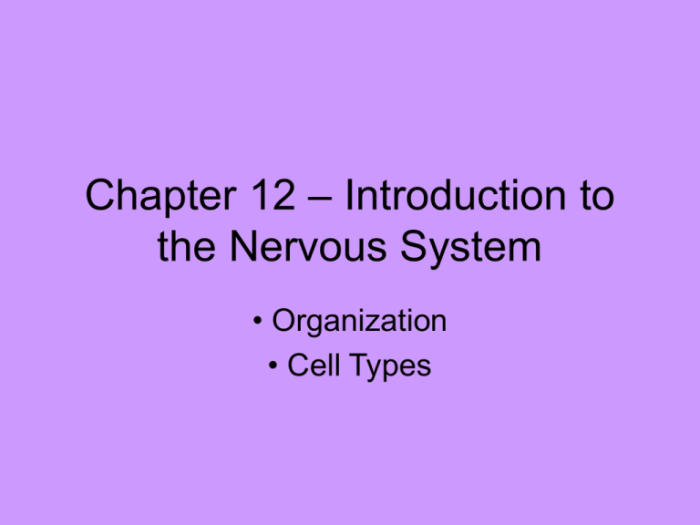
Neurons are the fundamental units of the nervous system, responsible for transmitting information throughout the body. They possess a unique structure and specialized functions that enable them to communicate with each other and control various bodily processes.Neurons consist of three main components: the cell body (soma), dendrites, and axon.
The cell body contains the nucleus and other essential organelles. Dendrites are short, branched extensions that receive signals from other neurons. The axon is a long, slender projection that transmits signals away from the cell body to other neurons, muscles, or glands.
Types of Neurons
There are various types of neurons, each with a specific role in the nervous system. Sensory neurons receive stimuli from the external environment or internal organs and transmit this information to the central nervous system (CNS). Motor neurons carry signals from the CNS to muscles or glands, causing them to contract or secrete substances.
Interneurons connect different neurons within the CNS, forming complex neural circuits.
Neurotransmission and Synaptic Plasticity
Neurons communicate with each other through neurotransmission, the process of releasing chemical messengers called neurotransmitters into the synaptic cleft, the space between neurons. Neurotransmitters bind to receptors on the receiving neuron, triggering electrical or chemical changes that influence its activity.Synaptic
plasticity refers to the ability of synapses to change their strength over time in response to repeated or altered patterns of activity. This process underlies learning, memory, and adaptation to changing environmental conditions.
Neuroanatomy and Neurophysiology
Neuroanatomy and neurophysiology delve into the intricate structure and function of the nervous system. This field explores the major anatomical components, pathways, and fundamental principles that govern the communication and processing of information within the nervous system.
Major Neuroanatomical Structures and Pathways
The nervous system is composed of specialized structures that work in concert to facilitate communication and control. These structures include the brain, spinal cord, and peripheral nerves. The brain, the central processing unit of the nervous system, is divided into various regions, each with distinct functions.
Chapter 22 on the nervous system delves into the intricate network of neurons that control our body’s functions. However, if you’re looking to brush up on your algebra skills, I highly recommend checking out the algebra eoc practice test 2 . Once you’ve conquered those equations, come back to Chapter 22 and explore how the nervous system orchestrates our every move.
The spinal cord serves as a conduit for communication between the brain and the rest of the body. Peripheral nerves extend from the brain and spinal cord to connect with muscles, organs, and sensory receptors throughout the body.
Within these structures, intricate pathways facilitate the transmission of information. Sensory pathways carry sensory information from receptors in the body to the brain, while motor pathways transmit signals from the brain to muscles and glands. Association pathways connect different regions of the brain, enabling communication and integration of information.
Basic Principles of Neurophysiology
Neurophysiology elucidates the fundamental mechanisms that govern the functioning of the nervous system. These principles include:
- Action Potentials:Electrical impulses that transmit information along neurons.
- Synaptic Transmission:The process by which neurons communicate with each other at specialized junctions called synapses.
- Neural Circuits:Interconnected networks of neurons that process and transmit information.
Techniques for Studying the Nervous System
Researchers employ a variety of techniques to investigate the structure and function of the nervous system. These include:
- Electroencephalography (EEG):Records electrical activity in the brain using electrodes placed on the scalp.
- Magnetic Resonance Imaging (MRI):Utilizes magnetic fields and radio waves to create detailed images of the brain and spinal cord.
- Functional Magnetic Resonance Imaging (fMRI):Measures changes in blood flow in the brain to assess brain activity during specific tasks.
Disorders of the Nervous System: Chapter 22 The Nervous System
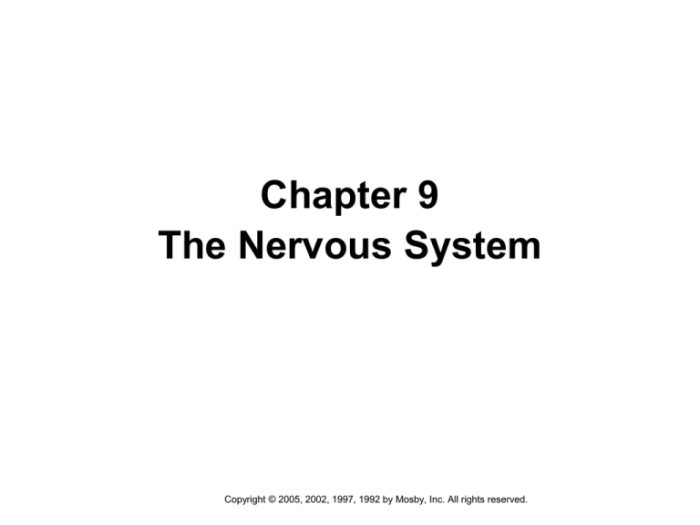
The nervous system is a complex and intricate network of cells, tissues, and organs that coordinate and control all bodily functions. However, this intricate system is not immune to disorders that can disrupt its delicate balance, leading to a wide range of neurological conditions.
Alzheimer’s Disease
Alzheimer’s disease is a progressive neurodegenerative disorder that primarily affects the elderly population. It is characterized by a gradual decline in cognitive function, memory loss, and behavioral changes. The exact cause of Alzheimer’s disease remains unknown, but genetic factors, age, and lifestyle choices are believed to play a role.
Symptoms of Alzheimer’s disease can vary depending on the stage of the disorder. In the early stages, individuals may experience mild memory lapses and difficulty concentrating. As the disease progresses, cognitive impairment becomes more severe, leading to confusion, disorientation, and impaired judgment.
In the later stages, individuals may lose the ability to communicate, recognize familiar faces, and perform basic daily activities.
There is currently no cure for Alzheimer’s disease, but treatments are available to manage symptoms and slow the progression of the disorder. Medications such as cholinesterase inhibitors and memantine can help improve cognitive function and memory. Other therapies, such as cognitive stimulation therapy and physical exercise, can also provide support and improve quality of life for individuals with Alzheimer’s disease.
Parkinson’s Disease
Parkinson’s disease is another neurodegenerative disorder that primarily affects the elderly population. It is characterized by tremors, rigidity, slow movement, and impaired balance. The exact cause of Parkinson’s disease is unknown, but genetic factors, age, and environmental toxins are believed to play a role.
Symptoms of Parkinson’s disease can vary depending on the stage of the disorder. In the early stages, individuals may experience mild tremors in their hands or feet. As the disease progresses, tremors become more severe and may affect other parts of the body.
Rigidity and slow movement can also develop, making it difficult to perform everyday tasks. In the later stages, individuals may lose the ability to walk or talk.
There is currently no cure for Parkinson’s disease, but treatments are available to manage symptoms and improve quality of life. Medications such as levodopa and dopamine agonists can help reduce tremors and improve movement. Other therapies, such as physical therapy and speech therapy, can also provide support and improve daily function.
Epilepsy
Epilepsy is a neurological disorder characterized by recurrent seizures. Seizures are sudden, uncontrolled bursts of electrical activity in the brain that can cause a variety of symptoms, including loss of consciousness, convulsions, and sensory disturbances. The exact cause of epilepsy is unknown, but genetic factors, head injuries, and certain medical conditions are believed to play a role.
Symptoms of epilepsy can vary depending on the type of seizure. Some individuals may experience only mild seizures that cause brief lapses in consciousness, while others may experience severe seizures that can lead to loss of consciousness, convulsions, and injuries.
There is currently no cure for epilepsy, but treatments are available to control seizures and improve quality of life. Medications such as anticonvulsants and antiepileptic drugs can help prevent seizures or reduce their severity. Other therapies, such as surgery and vagus nerve stimulation, may also be considered for individuals who do not respond to medication.
Answers to Common Questions
What is the primary function of the nervous system?
The nervous system serves as the body’s communication and control center, facilitating interactions between different organs, tissues, and cells, and enabling us to respond to external stimuli and maintain homeostasis.
What are the two main divisions of the nervous system?
The nervous system is broadly divided into the central nervous system (CNS), comprising the brain and spinal cord, and the peripheral nervous system (PNS), which includes all the nerves that extend from the CNS to the rest of the body.
What is the role of neurons in the nervous system?
Neurons are the fundamental units of the nervous system, responsible for transmitting information throughout the body via electrical and chemical signals. They receive, process, and transmit information, forming intricate networks that facilitate communication and coordination within the organism.
